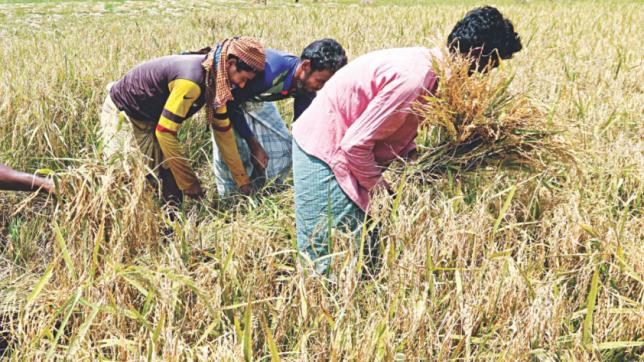Paddy output to rise: FAO

Paddy output is likely to rise 4 percent year-on-year to 5.36 crore tonnes during the current calendar year, because of higher plantings by growers and favourable weather, said the Food and Agriculture Organization (FAO) recently.
The overall production of the staple food would be higher than the five-year annual average of 5.17 crore tonnes (equivalent of around 3.53 crore tonnes of rice) between 2013 and 2017.
The forecast comes as farmers are harvesting the aman paddy crop, the second biggest crop after boro, in various parts of the country and ample supply pushes down the prices of rice in the market.
The United Nations agency said data involving aman paddy, which accounts for about 40 percent of the annual production, would be finalised in January.
“Production prospects are favourable reflecting an above average area planted, supported by remunerative producer prices at planting time and expectations of bumper yields following beneficial weather conditions,” it said.
The FAO referred to harvest of boro and aus earlier this year, saying that official estimates indicate record outputs reflecting the high level of plantings due to strong domestic prices and bumper yields facilitated by favourable weather conditions.
The Bangladesh Bureau of Statistics (BBS) estimated that boro rice production rose 8.67 percent year-on-year to 1.95 crore tonnes in 2018 from that a year ago.
An estimate for aus rice production is yet to be released by the BBS.
But the Department of Agricultu-ral Extension (DAE) puts the aus rice production figure at 29 lakh tonnes, up 7 percent from that a year ago.
The FAO said, because of ample supply from record output, Bangladesh's rice imports may decline to 8.50 lakh tonnes in fiscal 2018-19. Total rice import hit a record at 38.92 lakh tonnes the previous year. During the current fiscal year, one lakh tonnes of rice were imported between July 1 and December 12, according to food ministry data. However, wheat import requirements are estimated at a record level of 60 lakh tonnes in the current fiscal year, said the FAO.
“The strong demand for wheat reflects a shift in consumers' diet preferences as well as the increased use as a substitute for more expensive rice,” it said, adding that maize imports were expected to increase to 17 lakh tonnes due to sustained demand for feed.
Overall, cereal import requirement in the July-June period of 2018-19 is estimated at 86 lakh tonnes, almost 30 percent above the five-year average and 22 percent less than the previous year's unusual high, FAO said.
Apart from increased imports, maize production also rose 6 percent year-on-year to 32 lakh tonnes in 2018, reflecting increased plantings to meet rising demand.
The FAO also forecasts that wheat production may drop to 13 lakh tonnes, slightly below the five-year average, due to a contraction in plantings as farmers preferred to shift to more remunerative crops such as paddy.
